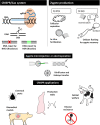CRISPR in livestock: From editing to printing
- PMID: 32088034
- PMCID: PMC7102594
- DOI: 10.1016/j.theriogenology.2020.01.063
CRISPR in livestock: From editing to printing
Abstract
Precise genome editing of large animals applied to livestock and biomedicine is nowadays possible since the CRISPR revolution. This review summarizes the latest advances and the main technical issues that determine the success of this technology. The pathway from editing to printing, from engineering the genome to achieving the desired animals, does not always imply an easy, fast and safe journey. When applied in large animals, CRISPR involves time- and cost-consuming projects, and it is mandatory not only to choose the best approach for genome editing, but also for embryo production, zygote microinjection or electroporation, cryopreservation and embryo transfer. The main technical refinements and most frequent questions to improve this disruptive biotechnology in large animals are presented. In addition, we discuss some CRISPR applications to enhance livestock production in the context of a growing global demand of food, in terms of increasing efficiency, reducing the impact of farming on the environment, enhancing pest control, animal welfare and health. The challenge is no longer technical. Controversies and consensus, opportunities and threats, benefits and risks, ethics and science should be reconsidered to enter into the CRISPR era.
Keywords: Cows; Gene editing; Goats; Pigs; Sheep.
Copyright © 2020 Elsevier Inc. All rights reserved.
Figures

References
-
- UN . Affairs DoEaS. United Nations; New York: 2017. World population prospects: the 2017 revision, key findings and advance tables.
-
- WB . Development IBfRa. World Bank Group; Washington: 2018. Piecing together the poverty puzzle.
-
- FAO . Food and agriculture organization; 2009. How to feed the world in 2050.
-
- Horvath P., Barrangou R. CRISPR/Cas, the immune system of bacteria and archaea. Science (New York, NY) 2010;327:167–170. - PubMed
Publication types
MeSH terms
LinkOut - more resources
Full Text Sources

